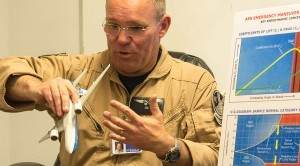 In August of 2014 Upset Prevention and Recovery Training (UPRT) became a requirement for all new candidates for the Airline Transport Pilot certificate in the United States. Beginning in November of 2014 the International Civil Aviation Organization (ICAO) has recommended that all pilots receive UPRT in actual flight prior to receiving their Commercial Pilot License. With the implementation of this new aspect of training for pilots, it would be reasonable to expect that there would be a great deal of consensus for what UPRT actually is. That is not the case.
In August of 2014 Upset Prevention and Recovery Training (UPRT) became a requirement for all new candidates for the Airline Transport Pilot certificate in the United States. Beginning in November of 2014 the International Civil Aviation Organization (ICAO) has recommended that all pilots receive UPRT in actual flight prior to receiving their Commercial Pilot License. With the implementation of this new aspect of training for pilots, it would be reasonable to expect that there would be a great deal of consensus for what UPRT actually is. That is not the case.
In both cases it is fair to say that these governing bodies view UPRT to be whatever it takes to stop the tide. The tide being the fatalities stemming from Loss of Control In-flight (LOC-I), which has become the number one cause of fatal accidents in aviation. For the FAA, ICAO, and other regulatory bodies such as the European Aviation Safety Agency (EASA) that are studying their options, the changes calling for UPRT are the result of an increasing awareness that unless something is done LOC-I will remain the leading killer of pilots and passengers in aviation. It is clear from the variety of ways that a LOC-I accident can develop that the best way to defeat the threat across the board is to improve the last line of defense available by training pilots in command in upset prevention and recovery.
ICAO has done a good job of describing what UPRT is in general while leaving the details of specification up to the individual National Aviation Authorities. The need for such definition is important for maintaining safety in multiple ways. If UPRT does not extend beyond the scope of today’s existing training standards it will have no effect on the LOC-I accident rate. Changing the name of training from unusual attitudes and approach to stall to UPRT is not likely to effect the required change.
If the instructor has not been specifically qualified to teach UPRT then there are two ways that safety can be impacted with two very different levels of exposure. In training UPRT in a simulator, no one is likely to be hurt by the training itself; one of the great safety benefits of flight simulation. In that case errant instruction may not surface for years, and even then only if an unanticipated airplane upset is encountered. In the case of on-aircraft delivered UPRT the risks are much more apparent and immediate.
In delivering the all-attitude/all-envelope training that UPRT must provide, in order to alter the status quo, the qualifications of the instructor conducting the training are arguably the greatest single factor in preserving the safety of UPRT operations. We must know what aspects of UPRT instructors are responsible for training in order to identify how they must be qualified. Only through identifying risks can we identify appropriate risk mitigation. Without knowing what the instructor must train, it is hard to determine what the instructor must be prepared for, what flight conditions might be encountered, and what risks might be posed.
Fortunately, Aviation Performance Solutions (APS) is well ahead of the authorities in determining what the requirements are for our own instructors. First, from the standpoint of risk mitigation for UPRT operations, all APS instructors have extensive operational experience in the all-attitude/all-envelope domain. Whether as military fighter pilots, test pilots, airshow demonstration pilots, or unlimited category aerobatic competitors, all APS instructors have experience measured in years of professional experience in the world of all-attitude/all-envelope flight operations.

While the right flight experience may be enough to ensure the ability to handle the results of training-related departures from controlled flight, it does not ensure the ability to effectively convey information, which is the instructor’s primary role. APS only selects individuals with extensive backgrounds in flight instruction who also possess operational experience in business aircraft or airline aircraft flight operations. This “right-side up” experience is essential for understanding the operating environment that our customers operate in so that we can relate to the risks they face and provide our training in that context. Those three pillars of experience – instructional, all-attitude/all-envelope, and normal flight operations – are tied together with an industry-leading instructor qualification program to ensure that all APS instructors are standardized and quality-assured to the highest level of UPRT instructional capability in the aviation industry.
Randall Brooks, APS VP Training and Business Development
Aviation Performance Solutions




Comments: